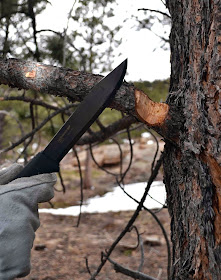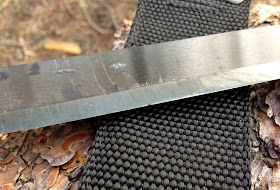For some time now, I have been looking for a small but reliable compass that I could stash anywhere for emergency use. Although many respected compass makers make small versions, I have yet to find one that was as reliable as their full sized compasses. I'm not sure why small tends to equal lower quality, it just seems to be the way of things. After lots of searching, I ran across CountyComm's SERE Compass and Thumb Tac Compass.
CountyComm is a government contractor that designs, manufactures and sells select products to federal, state and local government agencies. They sell some of their excess inventory to the public through their website.
FEATURES
The impossibly tiny Thumb Tac Compass is literally as small as the head of a thumbtack. Per military specifications, it is small enough to be sewn into hidden areas of the clothing of a pilot or special ops soldier, where it would be hard to detect should either get captured and held prisoner.
Thumb Tac SAS Compass:
Photo credit: CountyComm
CountyComm's SERE (SURVIVAL, EVASION, RESISTANCE, ESCAPE) Compass is the Thumb Tac's bigger brother. When I say "bigger" however, I mean that it's bigger "relatively speaking." The SERE Compass is in actuality only slightly larger than a dime.
The SERE Compass features a Din sealed brass case, and is threaded with 45 lb braided nylon fish line.
SERE (SURVIVAL, EVASION, RESISTANCE, ESCAPE) Compass:
Photo credit: CountyComm
The directional markings are coated with luminous paint to aid in nighttime navigation:
CountyComm also has a Youtube video on the SERE Compass which you can see here.
FIELD TESTING
To test the compasses, I carried them with me on several mountain hikes and checked them against a full-size Brunton O.S.S. 50M compass to see if they pointed in the same direction. Both compasses were dead-on with the larger Brunton compass.
I also took the SERE Compass with me on a night hike to see if the luminescent paint glowed bright enough to navigate. The SERE compass worked as advertised and the directional markings were easily visible in the dark.
Conclusion
I
came away impressed with the diminutive CountyComm compasses. The
military-spec construction makes them rugged, reliable, and accurate.
Though
both compasses functioned well, I prefer the larger SERE Compass for
real world use. The SERE Compass' larger size makes it easier to use, the lanyard makes it easier to carry without losing it, and the
luminescent markings make it functional for night navigation.
The
SERE Compass is also small enough to fit in the spare compartment of
most survival knife sheaths (such as my Ontario SP50), as well as an
Altoids-can-sized personal survival kit (PSK).
On
the negative side, neither compass has degree markings or adjustable
declination, so they're definitely not a replacement for a full-sized
baseplate/orienteering compass if you want to navigate with a topo map.
The SERE and Thumb Tac compasses are designed to be very basic survival
compasses that will help you determine direction and rough headings.
All
in all, the CountyComm compasses, especially the SERE Compass, are
great tools to throw into your micro-survival kit. They also have an
undeniably cool "James Bond" appeal, with the functionality and military
toughness to back it up.
4.5 out of 5 Stars (Highly Recommended)
For more information visit www.countycomm.com
About the author
 Jason Schwartz is the founder and senior editor of Rocky Mountain Bushcraft. He is a former Red Cross certified Wilderness & Remote First Aid Instructor, and has taught bushcraft and wilderness survival techniques to the Boy Scouts of America, interned with the US Forest Service, and studied wilderness survival, forestry and wildland firefighting at Colorado Mountain College in Leadville, Colorado. Jason has also written for magazines such as The New Pioneer and Backpacker, including writing the "Tinder Finder" portion of Backpacker's "Complete Guide to Fire," which won a 2015 National Magazine Award (NMA). Email him at rockymountainbushcraft @ hotmail.com (without spaces)
Jason Schwartz is the founder and senior editor of Rocky Mountain Bushcraft. He is a former Red Cross certified Wilderness & Remote First Aid Instructor, and has taught bushcraft and wilderness survival techniques to the Boy Scouts of America, interned with the US Forest Service, and studied wilderness survival, forestry and wildland firefighting at Colorado Mountain College in Leadville, Colorado. Jason has also written for magazines such as The New Pioneer and Backpacker, including writing the "Tinder Finder" portion of Backpacker's "Complete Guide to Fire," which won a 2015 National Magazine Award (NMA). Email him at rockymountainbushcraft @ hotmail.com (without spaces)
 Jason Schwartz is the founder and senior editor of Rocky Mountain Bushcraft. He is a former Red Cross certified Wilderness & Remote First Aid Instructor, and has taught bushcraft and wilderness survival techniques to the Boy Scouts of America, interned with the US Forest Service, and studied wilderness survival, forestry and wildland firefighting at Colorado Mountain College in Leadville, Colorado. Jason has also written for magazines such as The New Pioneer and Backpacker, including writing the "Tinder Finder" portion of Backpacker's "Complete Guide to Fire," which won a 2015 National Magazine Award (NMA). Email him at rockymountainbushcraft @ hotmail.com (without spaces)
Jason Schwartz is the founder and senior editor of Rocky Mountain Bushcraft. He is a former Red Cross certified Wilderness & Remote First Aid Instructor, and has taught bushcraft and wilderness survival techniques to the Boy Scouts of America, interned with the US Forest Service, and studied wilderness survival, forestry and wildland firefighting at Colorado Mountain College in Leadville, Colorado. Jason has also written for magazines such as The New Pioneer and Backpacker, including writing the "Tinder Finder" portion of Backpacker's "Complete Guide to Fire," which won a 2015 National Magazine Award (NMA). Email him at rockymountainbushcraft @ hotmail.com (without spaces)
















































